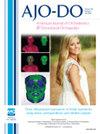Relationship between discrimination, personality traits, and dentofacial features among schoolchildren in Jordan
IF 3
2区 医学
Q1 DENTISTRY, ORAL SURGERY & MEDICINE
American Journal of Orthodontics and Dentofacial Orthopedics
Pub Date : 2025-06-01
DOI:10.1016/j.ajodo.2024.12.009
引用次数: 0
Abstract
Introduction
The objective of this study was to evaluate the influence of dentofacial features on experiences of discrimination and to examine their potential association with personality factors among schoolchildren in Jordan.
Methods
This cross-sectional study involved 1166 ninth and tenth-grade school children, comprising 707 girls and 459 boys, aged 14-16 years (mean age 14.97 ± 0.84 years). Participants were recruited from randomly selected schools and requested to complete 2 questionnaires. The first questionnaire investigated discrimination experiences, and the second was the NEO Five-Factor Inventory questionnaire, which was used to assess the participants’ 5 major personality factors: neuroticism, extraversion, openness, agreeableness, and conscientiousness. Relationships among variables were identified using chi-square and Fisher exact tests. Variations based on sex and the presence of discrimination were identified using the Mann-Whitney U test. Hierarchical logistic regression analysis was conducted to determine the odds of being exposed to discrimination based on dental problems and personality factors. Statistical significance was determined at 95% confidence intervals, with 2-tailed α values of ≤0.05.
Results
The prevalence of reported discrimination was 58.8% (n = 686); significantly more girls reported being discriminated against than boys (P <0.001). Approximately 20% of the participants reported being discriminated against because of their dentofacial features. The 3 most commonly reported dentofacial features the discriminated against participants identified were tooth color (6.9%), spacing between teeth (6.6%), and proclined maxillary anterior teeth (5.1%). Hierarchical logistic regression analysis demonstrated that higher neuroticism scores, higher openness scores, and problems with dental or oral features were associated with higher odds of being exposed to discrimination (P <0.05).
Conclusions
Jordanian students reported a high incidence of discrimination, which was often linked to their dental or facial appearance. This discrimination was significantly associated with personality traits and specific dentofacial features.
约旦学龄儿童的歧视、人格特征和牙面特征的关系
前言:本研究的目的是评估牙面特征对歧视经历的影响,并研究其与约旦学童人格因素的潜在关联。方法:本横断面研究纳入1166名九、十年级儿童,其中女生707人,男生459人,年龄14-16岁(平均年龄14.97±0.84岁)。参与者从随机选择的学校中招募,并被要求完成两份问卷。第一份问卷调查被试的歧视经历,第二份是NEO五因素量表,用于评估被试的神经质、外向性、开放性、宜人性和尽责性5个主要人格因素。使用卡方检验和Fisher精确检验确定变量之间的关系。基于性别的差异和歧视的存在是通过曼-惠特尼U测试确定的。通过层次逻辑回归分析,确定因牙齿问题和人格因素而遭受歧视的几率。在95%置信区间确定统计学显著性,双尾α值≤0.05。结果:报告的歧视发生率为58.8% (n = 686);结论:约旦学生报告受到歧视的发生率很高,这通常与他们的牙齿或面部外貌有关。这种歧视与人格特征和特定牙面特征显著相关。
本文章由计算机程序翻译,如有差异,请以英文原文为准。
求助全文
约1分钟内获得全文
求助全文
来源期刊
CiteScore
4.80
自引率
13.30%
发文量
432
审稿时长
66 days
期刊介绍:
Published for more than 100 years, the American Journal of Orthodontics and Dentofacial Orthopedics remains the leading orthodontic resource. It is the official publication of the American Association of Orthodontists, its constituent societies, the American Board of Orthodontics, and the College of Diplomates of the American Board of Orthodontics. Each month its readers have access to original peer-reviewed articles that examine all phases of orthodontic treatment. Illustrated throughout, the publication includes tables, color photographs, and statistical data. Coverage includes successful diagnostic procedures, imaging techniques, bracket and archwire materials, extraction and impaction concerns, orthognathic surgery, TMJ disorders, removable appliances, and adult therapy.

 求助内容:
求助内容: 应助结果提醒方式:
应助结果提醒方式:


